- Zbigniew Karkowski
- Constance Keene
- Gaetano Donizetti
- Alan Rawsthorne
- Antonin Reicha
- Falla
- fiction
- Salzkammergut
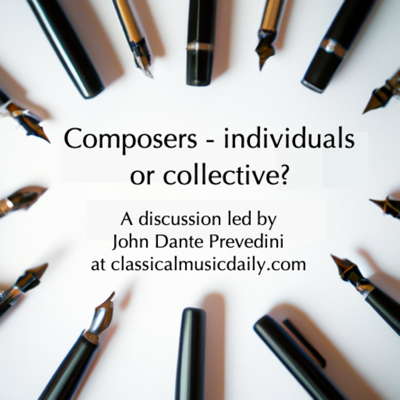 DISCUSSION: John Dante Prevedini leads a discussion about Composers, individuals or collective?, including contributions from David Arditti, Halida Dinova, Robert McCarney and Jane Stanley.
DISCUSSION: John Dante Prevedini leads a discussion about Composers, individuals or collective?, including contributions from David Arditti, Halida Dinova, Robert McCarney and Jane Stanley.
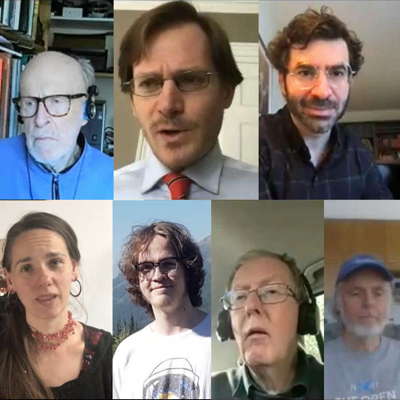 VIDEO PODCAST: John Dante Prevedini leads a discussion about Classical Music and Artificial Intelligence, including contributions from George Coulouris, Michael Stephen Brown, April Fredrick, Adrian Rumson and David Rain.
VIDEO PODCAST: John Dante Prevedini leads a discussion about Classical Music and Artificial Intelligence, including contributions from George Coulouris, Michael Stephen Brown, April Fredrick, Adrian Rumson and David Rain.
Gardiner's Falstaff
GIUSEPPE PENNISI visits Florence for a new production of Verdi's comic opera
Readers of this magazine have will have seen many reviews of mine about Falstaff, Giuseppe Verdi's last masterpiece. They were of productions from various Italian opera houses as well as from Berlin and Vienna. In this note on the new production staged at the Teatro del Maggio Musicale Fiorentino, I therefore draw only from the characteristics of the production, in my opinion salient and innovative, assuming that Shakespeare's story and its origins are well known. I saw and heard the opera on Sunday 21 November 2021.
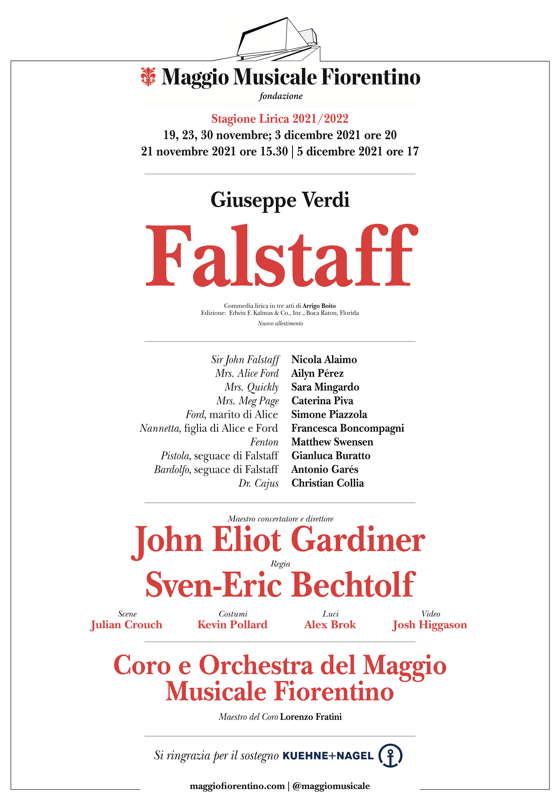
A brief introduction: in 1893, at the age of eighty, Verdi revolutionized musical theatre. Conventions and styles had already been overwhelmed a few years earlier, in 1890, by Cavalleria Rusticana from the young Pietro Mascagni. Unlike Cavalleria, which opened the doors to a style, verismo, which in Italy dominated musical theatre for a few decades, Falstaff by the 'old' Verdì launched a message that was captured only after thirty years by 'innovators' such as Alfredo Casella, Gian Francesco Malipiero and Luigi Dallapiccola. Today, it permeates much modern music, especially American. Casella, I think, was the first to recognize it.
On the one hand, Verdi's Falstaff is linked to the 'recitar cantando' (speaking in song) of musical theatre from the sixteenth and seventeenth centuries - completely forgotten by the second half of the eighteenth century. On the other, he opened the door to modern music in which – as Emilio Sala acutely wrote – 'words become sounds'. The distance from nineteenth century melodrama - even from the 'Verdi' one - is immense and it is also from the symphonism of what, in 1890 or so, was called 'the young school': the word and the music blend perfectly, as in 'recitar cantando' and in contemporary music. Except for a brief arioso by Ford and a romanza by Fenton, there are no 'pieces' or songs to be extrapolated for concerts, or to generate applause for the singer, but only polyphony, extensive use of mezze voci and an absolute theatricality, as in drama or comedy in contemporary music.
Only great conductors know how to grasp all the innovations that, while reconnecting to the origins of musical theatre, Falstaff contains. In Florence, Carlo Maria Giulini did it in 1983 and Zubin Mehta in 2006 and 2014. At La Scala, Antonino Votto in 1967 - when I was a student in Bologna and would arrive home by train at 5am after a La Scala performance - and Daniel Harding in 2013. Sir John Elliot Gardiner, a specialist in baroque music and whose Falstaff CD I remember about twenty years ago, surpasses them all, thanks to his vast experience with the music of the sixteenth and seventeenth centuries. Not only is the feature of the production the 'recitar cantando', but the interaction between pit and stage is perfect, the counterpoint masterful and the polyphony very accurate.
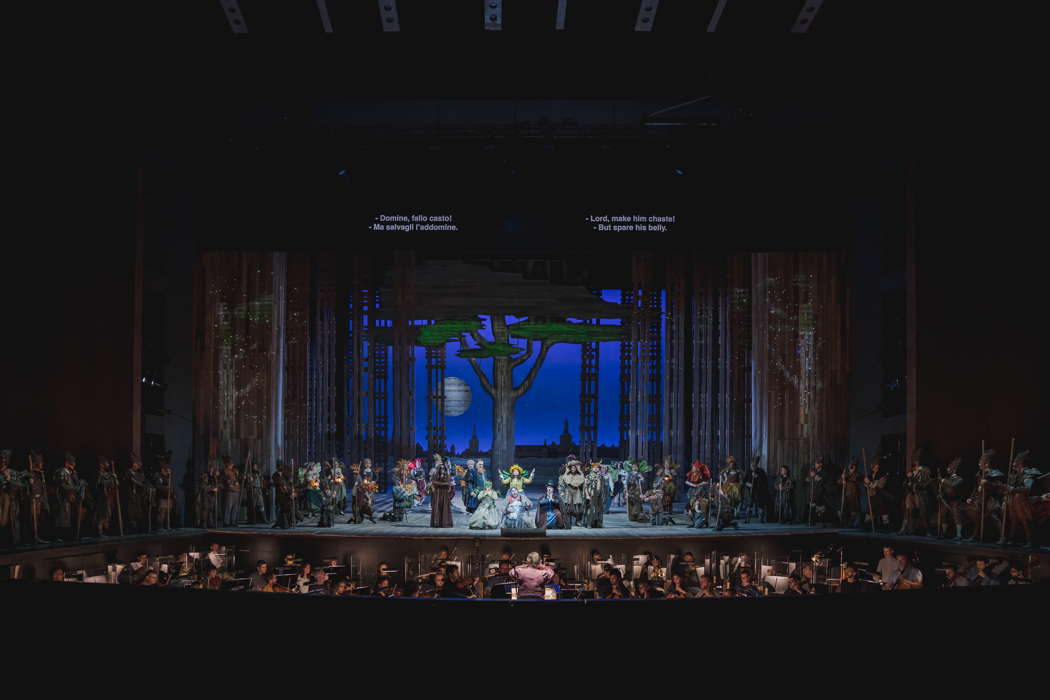
A scene from Verdi's Falstaff at the Teatro del Maggio Musicale Fiorentino. Photo © 2021 Michele Monasta
Just to focus on Florence productions, there is a profound difference between Giulini and Mehta's readings and this one by Gardiner. The first two were impregnated with melancholy - to simplify, the 'Va vecchio John' sets the tone for the opera. On the contrary, Gardiner from the beginning looks at the magnificent fugue - Bach, then forgotten, is relaunched by Verdi - and the happy skepticism of 'Tutto il mondo è una burla', a farewell from composition (and life) inimitable as well as never imitated.
Gardiner has a high-level cast: Nicola Alaimo, Simone Piazzola, Matthew Swensen, Christian Collia and Antonio Garés make up the men's group.
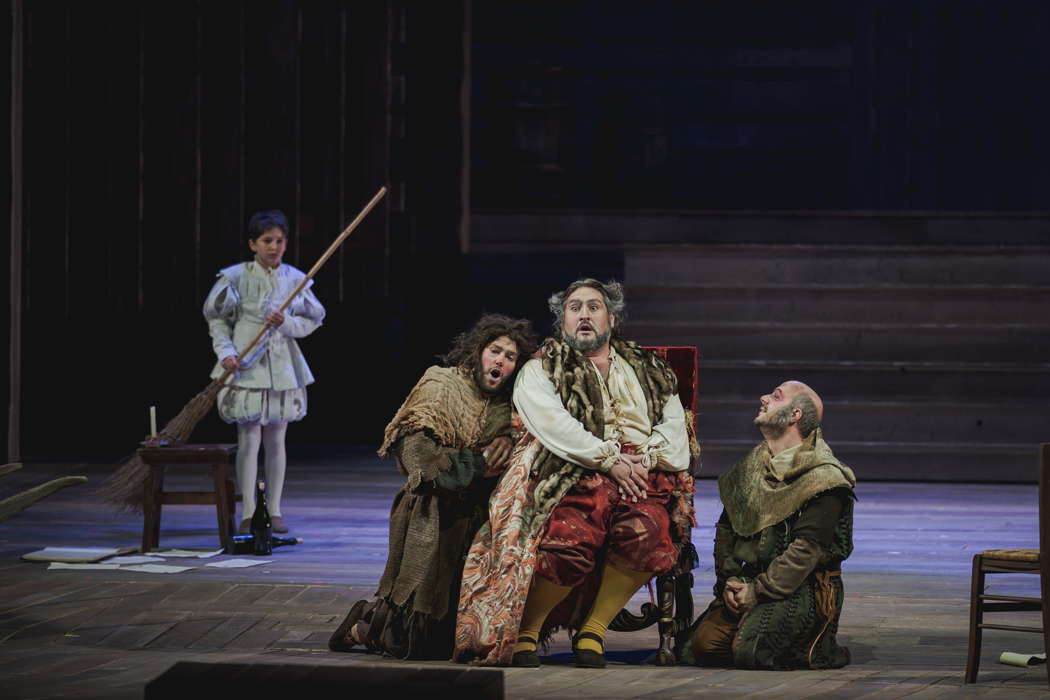
From left to right: an extra as the boy, Antonio Garés as Bardolfo, Nicola Alaimo as Sir John Falstaff and Gianluca Buratto as Pistola in Verdi's Falstaff at the Teatro del Maggio Musicale Fiorentino. Photo © 2021 Michele Monasta
Ailyn Pérez, Francesca Boncompagni, Sara Mingardo and Caterina Piva form the female quartet. There are many, especially among the female voices, with much experience of baroque music.
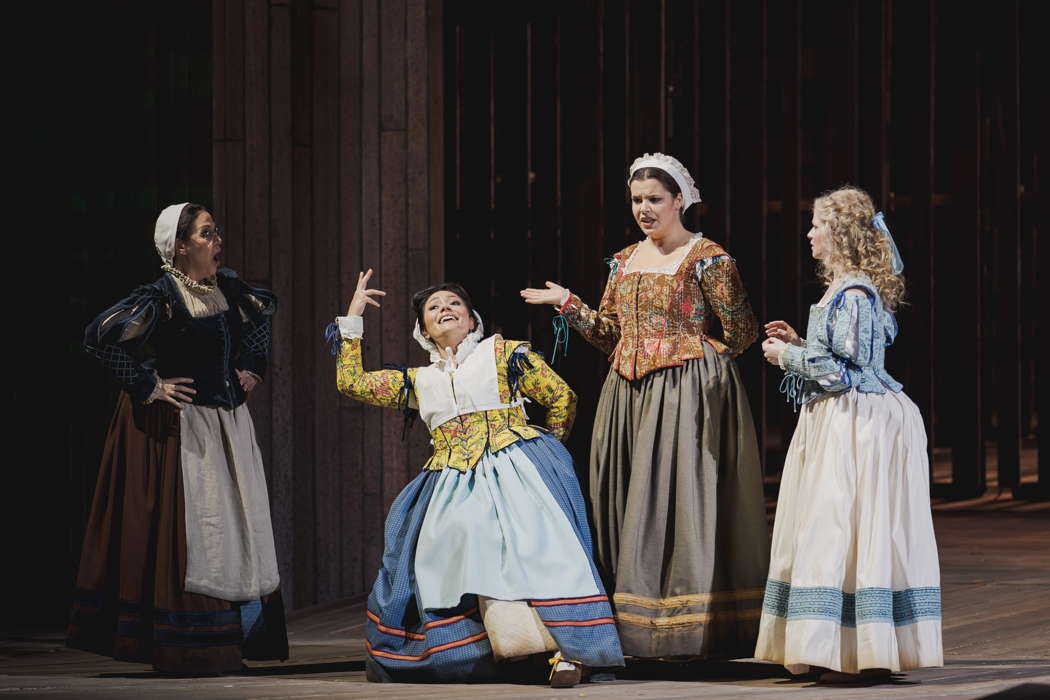
From left to right: Sara Mingardo as Mrs Quickly, Ailyn Pérez as Mrs Alice Ford, Caterina Piva as Mrs Meg Page and Francesca Boncompagni as Nannette in Verdi's Falstaff at the Teatro del Maggio Musicale Fiorentino. Photo © 2021 Michele Monasta
Gardiner has excellent stage direction too, by Sven-Eric Bechtolf, long-time director of dramaturgy at the Salzburg Festival, as well as sets (Julian Crouch) and costumes (Kevin Pollard) that take us to the Tudor Kingdom, a thousand miles away from the fantasies by La Fura dels Baus or from the obsessive projections by Davide Livermore. Also thanks to the effective lighting by Alex Brock and the elegant and restrained videos by Josh Higgason, you immediately enter the spirit and the mood of the production.
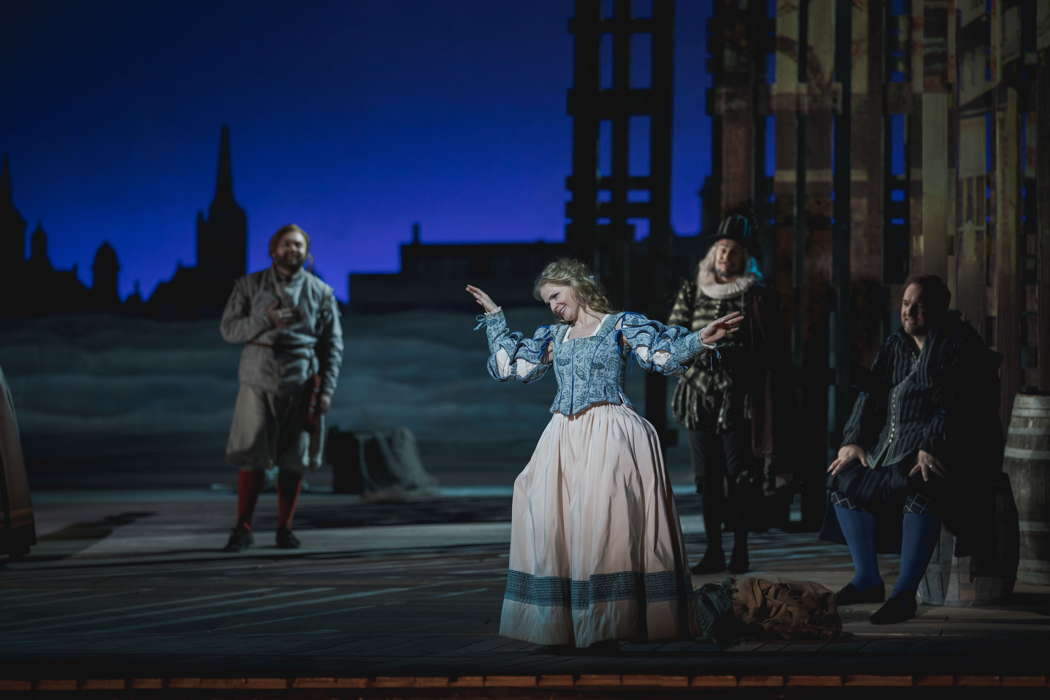
From left to right: Matthew Swensen as Fenton, Francesca Boncompagni as Nannette, Christian Collia as Dr Cajus and Simone Piazzola as Mr Ford in Verdi's Falstaff at the Teatro del Maggio Musicale Fiorentino. Photo © 2021 Michele Monasta
There were ovations and requests for an encore when the curtain fell. The whole company responded by repeating the final fugue.
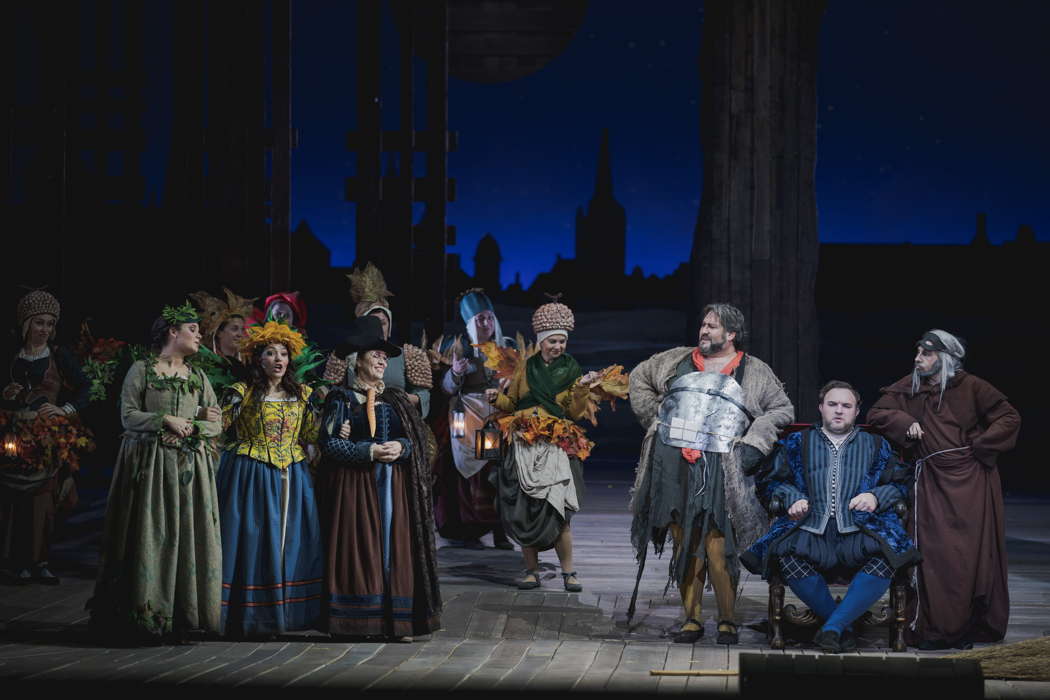
A scene from Verdi's Falstaff at the Teatro del Maggio Musicale Fiorentino. Photo © 2021 Michele Monasta
Unfortunately, many rows of seats were empty. The theatre was built to accommodate an audience of 1,800 - a size perhaps excessive for Florence alone, but hoping to attract, as in the past, bus-loads of fans from the rest of Tuscany and also from Umbria. Sadly, the pandemic discourages attendance at live performances.
Copyright © 3 December 2021
Giuseppe Pennisi,
Rome, Italy

MORE ARTICLES ABOUT SHAKESPEARE
MORE MAGGIO MUSICALE FIORENTINO ARTICLES


